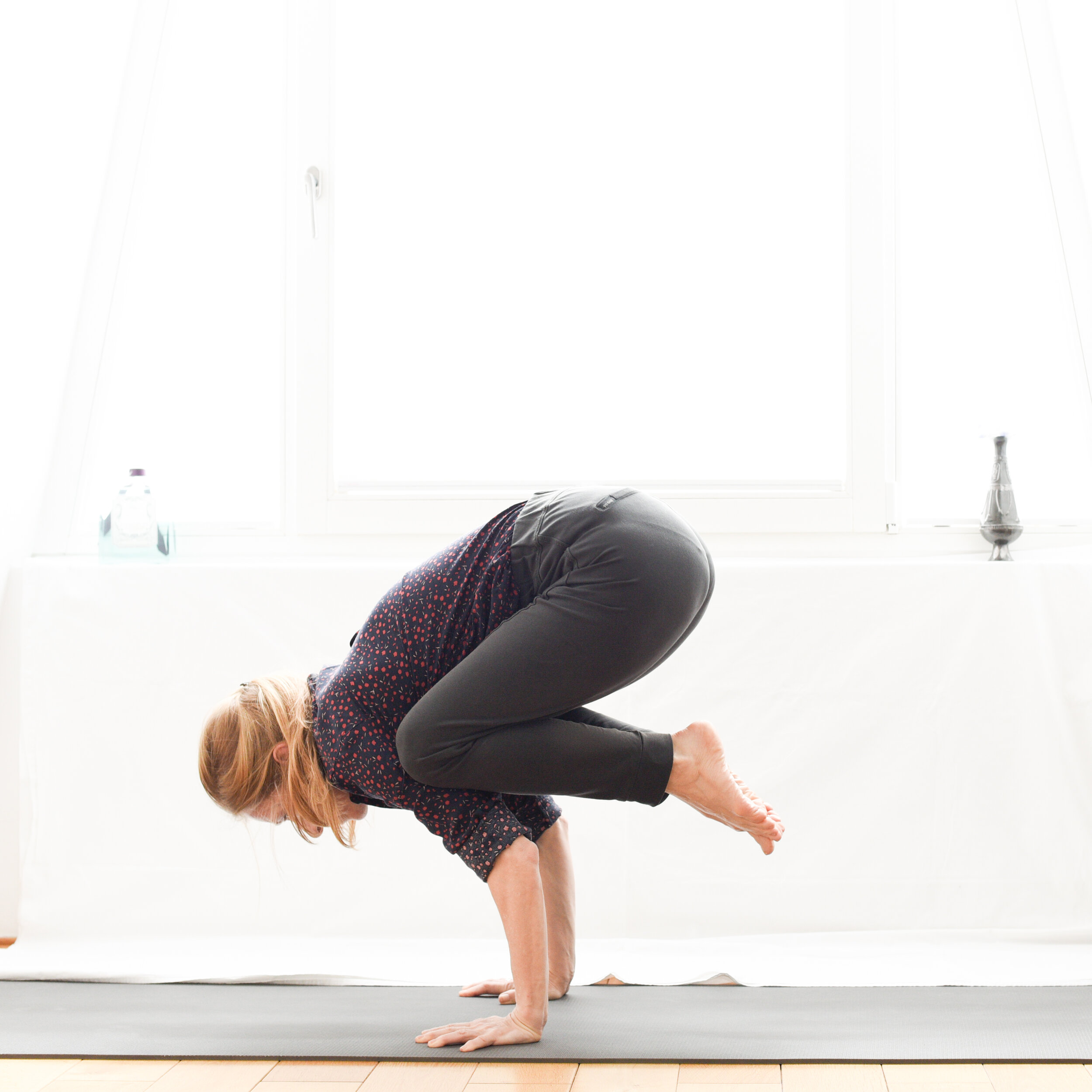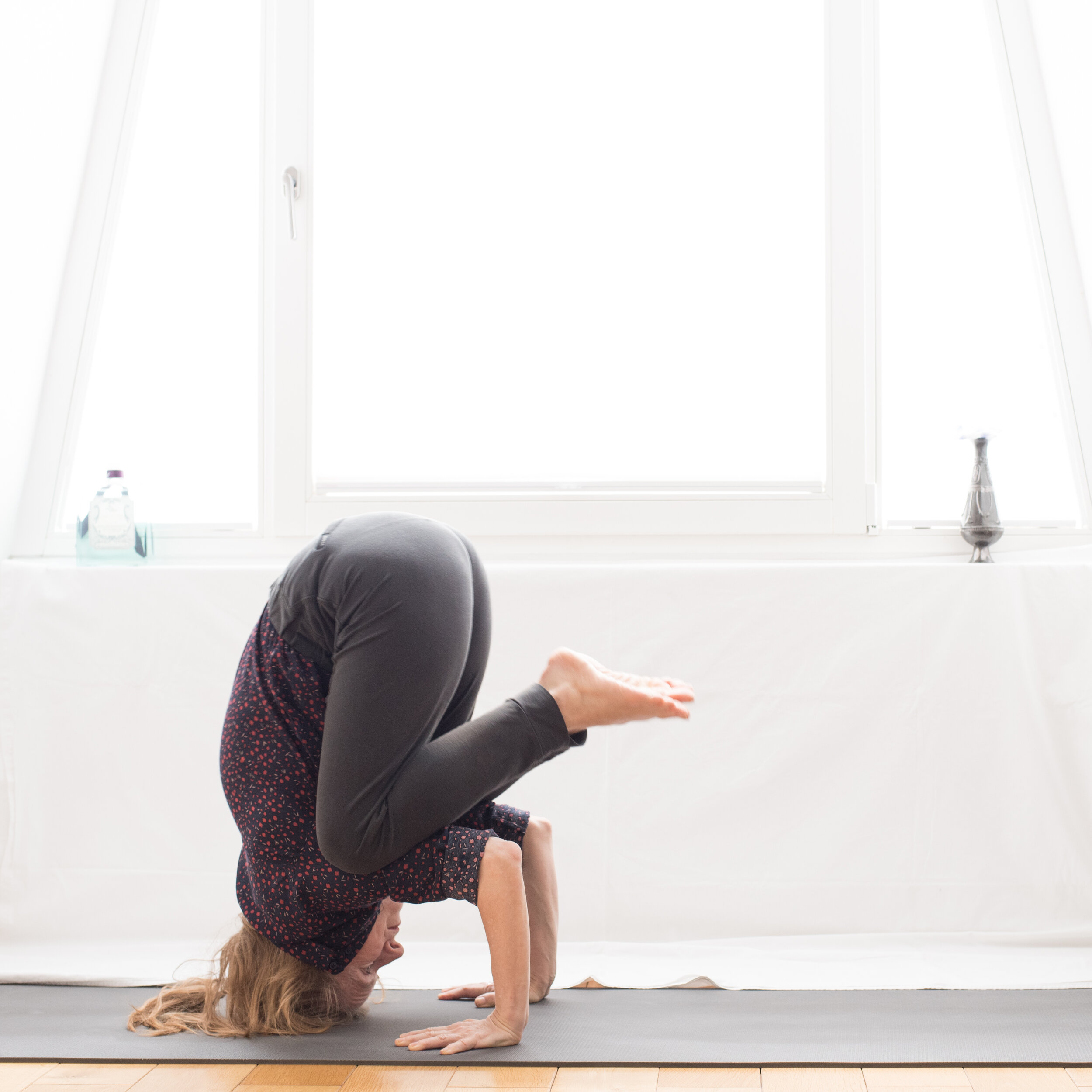Bala Kakasana, Kakasana and Bakasana
Let's start with the terminology. There is the baby crow, the crow and the crane. In Sanskrit, the three asanas are called bala kakasana, kakasana and bakasana.
You need strength to perform these three asanas. The muscles of the entire body are trained. The upper body carries the weight of the whole body. The abdomen must be tensed and pulled in. The legs must be kept in the air. All of this requires energy and strength.
I fooled myself once again with bala kakasana. This baby crow is also exhausting. I thought it would be an easy pose.
The nice thing is that you can integrate the postures well, for example after utkatasana. I usually practise bakasana after utkatasana. The special thing about bakasana is that the arms are stretched. I could do this pose before. I'm going to get it back again.
As a method for learning these asanas, I recommend repetitions and staying in the pose for longer.
Using the right technique is also very important. The hands are like claws. The upper body is rounded. The belly is pulled in. Bakasana becomes easier when the knees are close to the armpits. It is also easier to have the arms stretched from the beginning.
Have fun with the crow and the crane.
Embrace discomfort
Bakasana, Nov 2020
Since more than a decade I tried to eliminate all possible discomfort. I realize that it’s not possible. Discomfort comes, discomfort goes. Then something else arises at the horizon that isn’t pleasant.
I remember my pranayama teacher from India. He told me that he showers cold every day, even though warm water is available. He prepared himself for the times when warm water was not available.
We can learn to live with discomfort. Then it becomes easier to bear. An example: When I feel the stretching I focus also on the breath. I keep breathing evenly. This helps to relax despite the stretching discomfort.
Simply observing what happens is another method. With time we can learn to distinguish different sensations in the body. We might get closer and closer to our limits.
Discomfort helps us to learn and to grow:
A cold shower in the morning strengthens the immune system.
Taking the steps instead of the elevator is good for the heart.
Preparing meals is time-consuming, but healthier as the meals in restaurants.
The more often we face a difficult situation the easier it becomes to handle this situation.
Today I wanted to omit bakasana with straight arms. I’m not able to do it, I thought. But I tried it. It was not easy to move forward. I did it. When I saw the picture I loved it. Never before my arms were stretched like in the picture. This gives me self-confidence.
My lesson for today: Don’t avoid discomfort. Start easy. With time it becomes more and more satisfying to go through difficult situations. That’s how we learn.
Sitting on the sofa all day long is not really inspiring.
Keep practicing. Stay open for surprises.
November challenge
Bakasana variation, Nov 2020
We have another lockdown due to Covid-19 virus. It will last till the end of November. In addition it’s raining today. It’s autumn at its best. Few leaves hang on the trees till the next breeze will blow them to the ground. I cooked a spicy Indian inspired meal with potatoes and carrots. All restaurants are closed. Another months that gives me the opportunity to improve my cooking skills.
Carmen started another challenge called #pressingmatters. I’m in. Time shouldn’t be an issue. Every day is a good day to practice yoga.
Back to bakasana: The task is to hold this asana for one minute. I practice bakasana every day. Tomorrow I shall see how long I can hold this asana.
Balancing asanas
Carmens May challenge on Instagram is about balancing (#balanscience). My approach to these monthly challenges are playful. I’m less ambitious as many asanas are too advanced. I don’t want to risk injuries. I reflect on certain asanas. Sometimes I try new variations to see if I can integrate them into my practice. Mainly it’s fun to be part of a group of committed yogini. Some asanas are so challenging that I leave them out. The starting point is sometimes already my end asana……..
Balancing asanas vary a lot. One can fall out of a sitting asana, that has a balancing aspect. This is more or less funny. One can also fall out of handstand.
How to conquer the fear of falling?
Learn first to fall out of a pose. Learn a somersault.
Have enough space around yourself. Often injuries happen, because the student falls against things (yoga blocks) or the wall or a piece of furniture. Years ago I fell out of headstand. This happened once to me in my lifetime. I fell against the corner of a wall. This hurt and I got a huge bruise. If I had space I would have been shocked, but everything would have been OK.
Imagine what to do when you lose balance. In the above pose I know exactly what I have to do when I move too far forwards. Chin to chin. Then I land on my head (bone) and not on my nose or face. Falling usually happens very quickly. Exercise the exit and you won’t be surprised if it happens.
How to balance?
Engage the abdomen.
Breathe evenly.
Keep the eyes calm, gaze towards a point.
Ground yourself. In bakasana (picture) I feel more stable, when I try to turn the hands on the floor. Suddenly I become also stronger and more stable.
All the balancing asanas give self-confidence when mastered.
The balancing asanas force the mind to focus on the presence. Dreaming and thinking often comes with losing balance.
Utthita hasta padangusthasana is a standing asana. It’s a challenge to balance on one leg. I’m rather good at it these days. Yet when I start thinking I start wobbling. I remember days when I could perform this asana already very good. Then I started thinking: Oh, today is a good day. Et voilà. I started wobbling. Balancing asanas train the mind to focus on an even breath and to keep the eyes calm. If the core is strong in addition one can enjoy these asanas. Balancing asanas can give the feeling of weightlessness.
Carmen shows a tiny variation of bakasana on Instagram. She lowered the head. This makes the asana more difficult. My next step is rather to stretch the arms. Strong arms and core strength is needed to lift the body. This makes is possible to stretch the arms. To jump into this pose is another step further.
There is always a variation that is a bit more demanding. For me it’s important to know my next tiny step. When this tiny step is mastered, the journey can go on.





